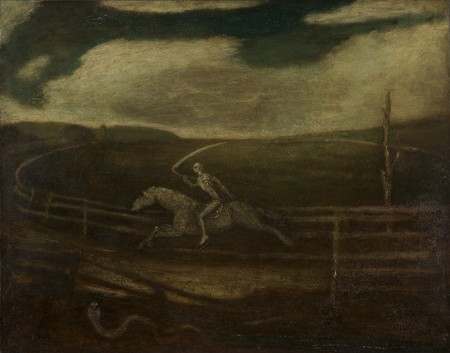In an 1883 issue of Art Journal, the writer W. M. Conway proposed that “the history of Art, in its widest sense, is the work appointed for the artists of our day.” My dissertation contends that the concerns behind such a directive formed a key preoccupation and problem for the influential late nineteenth-century American artist Albert Pinkham Ryder (1847–1917), and I turn to his paintings to consider what the conceptual contours and formal trajectories of this endeavor might have looked like. In 1890 the New York Times described Ryder as an artist set on “carry[ing] out the later styles of Rembrandt and Franz Hals after his own fashion” (giving
This study thus engages Ryder as a figure known for his unusual use of his media so as to address the overlooked question of the works’ motivations and their implications. By doing so, I account for the paintings in a way that neither ignores their material trajectories nor lets their current deteriorating conditions foreclose interpretive possibilities. For what is most striking about Ryder’s practices also, paradoxically, marked these “freaks” (as his paintings were once called) as representative of the cultural and intellectual environments of New York City. Once described by scholars as the “Century of History,” the nineteenth century was defined by a shifting consciousness of history as an issue of representation, an understanding that in turn attended the rise of the modern museum, the construction of distinct period styles, the flourishing of the photographic art album, and the popularity of historical novels. Given Ryder’s heterogeneous selection and revision of Barbizon pastorals, Shakespearean passages, biblical narratives, and seventeenth-century Dutch art, I contend that such works model and give rise to an altogether different order of “history” painting.
In this light, the dissertation’s central chapter reconsiders enigmatic works such as Ryder’s The Race Track, which features the allegorical subject of death on a pale horse suspended in mid- gallop on an empty path within an airless landscape. According to an anecdote once attributed to Ryder, a friend who worked as a hotel waiter in New York City bet his money on a racehorse in the Brooklyn Handicap. As the story goes, the horse lost, the bet fell through, and the waiter took his life shortly thereafter, prompting Ryder to embark on one of his largest and most unusual paintings. Overwrought yet deadpan in its effects, the painting simultaneously evokes and undoes the pictorial and rhetorical structure of another late nineteenth-century project that allegedly arose within the context of a widespread bet and debate concerning the particulars of equine locomotion—the acclaimed motion studies of the English photographer Eadweard Muybridge (1830–1904). By recasting the formal conventions of these ubiquitous photographs and the popular lectures that framed them, The Race Track locates and questions the visual and historical distance Muybridge’s lectures sought to obtain from earlier art-historical representations of the horse in motion. Indeed, the dense facture of The Race Track centers on what could be considered its most immaterial figures, those of the horse and rider, as if the duo’s overloaded weight of references—the “flying gallop,” death on a pale horse—could not help but be built up to the point of encrustation.
The remaining chapters reevaluate Ryder’s paintings as test cases for the task of periodization. To this end, the first chapter takes as its starting point Ryder’s claim that “Nature isn’t clean,” as he argued in 1911, criticizing a dealer who sought to remove the aging varnish from one of his paintings, “but it is the right matter in the right place, to paraphrase [Michael] Faraday.” I address the challenges these paintings continue to pose, given that Ryder repainted many over decades, ultimately confounding a strict linear chronology of his oeuvre. The final chapter investigates Ryder’s revisions of old master paintings and prints within the context of
